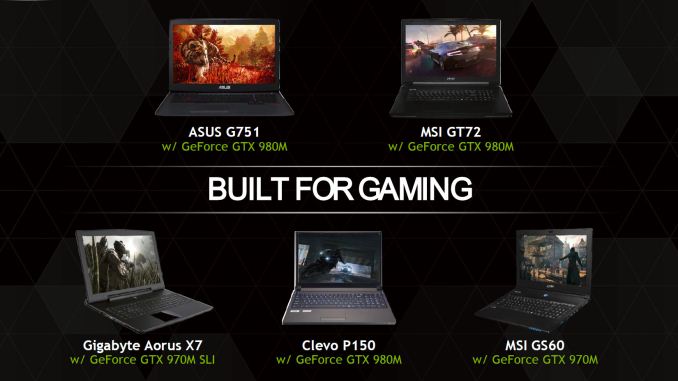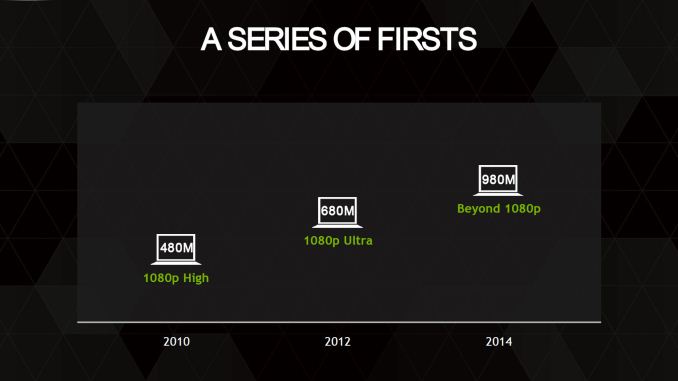NVIDIA GeForce GTX 980M and GTX 970M: Mobile to the Maxwell
by Jarred Walton on October 7, 2014 9:00 AM ESTGTX 980M and 970M Notebooks and Conclusion
Today's launch of 980M and 970M is about as much of a "hard launch" as we see with notebook GPUs. Quite a few notebooks should be available for order with the new chips, though it could take a couple weeks or more for orders to process. We were hoping to have the MSI GT72 prior to today's launch, but as noted earlier it should arrive in the next day (or in a few hours even). We'll post a follow-up Pipeline article as soon as we're able showing performance using some of our standard gaming and graphics benchmarks. In the meantime, here's the current list of notebooks that support the new GPUs.
| Upcoming GeForce GTX 980M/970M Notebooks | |||
| Manufacturer | Model | GPU | Size |
| ASUS | G751 | GeForce GTX 980M GeForce GTX 970M |
17” |
| MSI | GT72 | GeForce GTX 980M GeForce GTX 970M |
17” |
| MSI | GS60 | GeForce GTX 970M | 15” |
| MSI | GS70 | GeForce GTX 970M | 17” |
| Gigabyte | P35 | GeForce GTX 970M | 15” |
| Gigabyte | Aorus X7 | 2x GeForce GTX 970M (SLI) | 17” |
| Clevo | P150/P157 | GeForce GTX 980M GeForce GTX 970M |
15” |
| Clevo | P170/P177 | GeForce GTX 980M GeForce GTX 970M |
17” |
| Clevo | P650 | GeForce GTX 980M GeForce GTX 970M |
15” |
For their part, NVIDIA has provided performance numbers for both GPUs at different settings in a variety of games, but there's no comparison with other GPUs so the numbers are out of context. As a preview of what to expect, and considering several of the games use the built-in benchmark tools, here's what NVIDIA is reporting; all of the following games were tested at 1080p with the settings indicated:
| NVIDIA Performance Results | |||
| Game | Game Settings | GTX 980M | GTX 970M |
| Batman: Arkham Origins | Max, FXAA High, PhysX High | 60 | 45 |
| Battlefield 4 | Ultra | 66 | 49 |
| Bioshock Infinite | Ultra DX11_DDOF | 91 | 69 |
| Crysis 3 | Very High 4xMSAA | 36 | 26 |
| Far Cry 3 | Ultra 4xMSAA | 51 | 38 |
| Hitman Absolution | Ultra | 74 | 65 |
| Metro: Last Light | Very High SSAA | 36 | 27 |
| StarCraft II | Max 4xMSAA | 68 | 62 |
| Tomb Raider | Ultimate | 69 | 51 |
Most of the games are apparently being run at near maximum quality settings (though Batman is missing 4xMSAA, it does have PhysX enabled), which is good for putting as much of the bottleneck on the GPU as possible. StarCraft II and Hitman Absolution appear to be CPU limited, which isn't too surprising for StarCraft II as it has always been heavily influenced by CPU performance. On average, the GTX 980M outperforms the GTX 970M by 28%, even including the CPU limited games; if we ignore StarCraft II and Hitman Absolution the 980M is 34% faster on average.
Update: our own performance preview of GTX 980M is now available. The short summary is that GTX 980M is about the same performance level as the desktop GTX 770, though obviously with some newer features like DX12 support and VXGI. It's also twice as fast as the GTX 860M and 35% faster than GTX 880M on average.
One of the problems we're starting to run into with mobile GPUs getting so fast is that many laptops still top out at a 1920x1080 display, and even at maximum detail there are plenty of games that will easily break 60 FPS and may start running into CPU bottlenecks. For that reason, NVIDIA is billing the GTX 980M as a mobile GPU that targets playable frame rates at resolutions beyond 1080p, and we'll likely see more high-end notebooks ship with 2560x1440, 3K, or even 4K displays. It's probably a bit too much to assume that 3K gaming at 60 FPS will happen on most titles at maximum quality with the 980M, as games like Metro: Last Light and Crysis 3 can be very taxing, but we're definitely getting close to being able to max out settings on most games.
NVIDIA didn't provide specific numbers for their previous generation mobile GPUs, but they do note that GTX 980M should be around 40% faster than the GTX 880M, which is no mean feat. Compared to the first generation Kepler GPU, GTX 680M, the difference is even larger: 980M is roughly twice as fast as the GTX 680M that launched three years ago. GTX 970M is also supposed to be about 40% faster than the previous generation GTX 870M and on average twice as fast as the GTX 860M.
Wrapping up, we've provided a full gallery of slides from the NVIDIA presentation for those that are interested. We're very much looking forward to some hands on time testing out the GTX 980M, as it should prove to be quite a formidable GPU. That's not too surprising as GM204 proved to be quite potent on desktop GPUs, with a smaller and more efficient chip able to basically match and generally exceed the performance of l the larger and more power hungry GTX 780 Ti. The result is that this is as close as notebooks have come to matching desktop performance (for a single GPU) in as long as I've been reviewing notebooks.
Looking forward, performance is always improving and we'll certainly see even faster GPUs in the next year. We also know that NVIDIA is capable of making larger GPUs, so we're still missing the true "Big Maxwell" (i.e. GM200 or GM210). As with the GF110 and GK110 I don't expect we'll ever see that chip in consumer notebooks, but we might see GM204 return with even more SMMs enabled. But until NVIDIA comes out with an even bigger and faster Maxwell variant, this is the top mobile GPU, and that means it will priced as such.
We should see GTX 980M in gaming notebooks starting around the $2000 price point (give or take), with GTX 970M launching in notebooks starting at $1600. Based on MSI's pricing of their GT72, it also looks like the GTX 980M may have as much as a $350 price premium over the GTX 970M, or at least that's the difference in pricing for end users. (Ouch.) We're covering the notebooks that have been announced in separate Pipeline articles, and we should see some of them at the usual places like Newegg and Amazon. Stay tuned for our performance results from the MSI GT72, which will go up as soon as we get the laptop and can run some tests.






























68 Comments
View All Comments
ruggia - Tuesday, October 7, 2014 - link
Well, I think you meant stagnation in 1080p gaming requirement, not stagnation in GPU performance. PC cards have indeed reached the required performance of 1080p gaming 5 years ago. Since then, focus have been shifted on supporting higher resolutions (1440p/4k) or higher frame rates (100+Hz), which haven't been possible 5 years ago. Right now, even a low end card can easily best your GTX260 card without problem.ezorb - Tuesday, October 7, 2014 - link
I have an I7-920@3.2Ghz and a 2600k@4.5Ghz both rock solid. The single generation is just as great as the Core 2 to Nehalem , and the power consumption and noise are half on the sandy bridge and even less at idol. The 4770k@stock Ghz is faster than the 2600k@4.5Ghz, so I disagree, but clearly you have LOW standards cause i ditched the GTX 260 for a 5870, which was a massive improvmentEzioAs - Tuesday, October 7, 2014 - link
By your assumption, a 290X should be around 167% faster than the 5870...therefore an average performance increase of 41% per year.RussianSensation - Tuesday, October 7, 2014 - link
EzioAs,290X is 2.95X faster (or 195% faster) than an HD5870. Here are the breakdowns from 2009:
AMD = using 5870 as base of 100%
290X (max) = 295% (so nearly 3x faster)
HD7970Ghz = 229%
HD6970 = 129%
HD5870 = 100%
Nvidia = using 480 as base of 100%
980 (extrapolated from 780Ti) = 261%
780Ti = 248%
GTX680 = 162%
GTX580 = 119%
GTX480 = 100%
http://www.computerbase.de/2013-12/grafikkarten-20...
and
http://www.computerbase.de/2014-09/geforce-gtx-980...
Moving from 5870 (score of 30.1) vs. 980 (score of 105.1) is an increase of 3.49X. Therefore, GPU performance increased ~ 3.5X from the time HD5870 launched in Sept 2009 if one were to get a GTX980 today or an average increase of ~36.7% per year from 5870's launch.
nathanddrews - Tuesday, October 7, 2014 - link
60% of the time it works every time.EzioAs - Tuesday, October 7, 2014 - link
I was just correcting Razyre.His number indicates that the 7970 is 2x faster than the 5870 and the 290X is 30% faster than the 7970. You do the math, and you get that the 290X is 2.6x faster than the 5870.
RussianSensation - Tuesday, October 7, 2014 - link
Some good points. However, the only reason 980M is much closer to the 980 is because 980 is a mid-range Maxwell, GM200/210 will be high-end. The comparison NV uses is completely flawed because 880M is a mid-range Kepler (GK104) so of course it will be 50-60% as fast as the flagship of that generation - 780Ti. The same is true for 480 vs. 480M and 580 vs. 580M because 480 and 580 were flagship GPUs.Let's see what happens when GM200/210 come out and compare it to 1080M GM204 and the performance will grow again in favour of the desktop flagship GPU. NV is just playing marketing right now comparing a high-end mobile Maxwell card against a mid-range Maxwell desktop card by calling 980 a "flagship" desktop Maxwell chip -- which it isn't, even remotely.
azazel1024 - Tuesday, October 7, 2014 - link
It depends on how you define "not improved". My AMD 5570 just died a couple of days ago and I ordered a GTX750. Looking at just raw numbers, it is between 150-250% faster than my 5570. I'll grant it is maybe closer to a 5670 in terms of locating it on the performance tier...but even against a 5670 it is at a minimum >100% faster in everything and in most things still in the area of >150% faster. That is in basically 4 years, for the same price and very slightly higher to somewhat lower power consumption, you get more than doubled the performance.Sure, I wouldn't mind more, but I also won't complain either.
tviceman - Tuesday, October 7, 2014 - link
The performance delta between the 980m and 970m is disappointing. Since notebook parts typically don't overclock as well, a smaller delta of ~20% would have been sufficiently enough to keep the 980m well in front of the 970m. As it sits now, 30% is really, really large.EzioAs - Tuesday, October 7, 2014 - link
This is quite normal for Nvidia mobile GPUs right? Considering the price delta will also be just as high